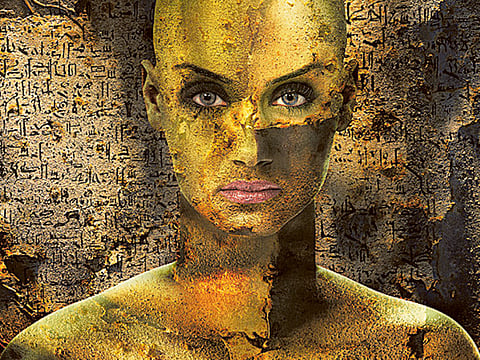Ayman Lotfy’s ‘Her’ is a study of society
Carefully staged photographs highlight socio-political issues

Well-known Egyptian photographer Ayman Lotfy used to be a fashion designer and art director in an advertising agency before he discovered his passion for photography. This is reflected in his first solo show in Dubai, titled “Her”.
The artist has combined photography, body painting, innovative costumes and accessories with theatrical backdrops and lighting to create compelling images that comment on contemporary socio-political issues. The photographs are all portraits of women, and the work addresses issues concerning women; but it is not only about women.
“For me a woman is a symbol of life and of my motherland, so the women in my photographs represent countries, regions and all of us. I am deeply engaged with what is happening in my country and in this region, and have always expressed my feelings and views through my photographs, films and videos. In my earlier works such as ‘The Game’ and ‘Nothing at All’, I have dealt with revolution, war and terrorism in a direct manner. But in this series I want to talk about human nature and the interaction between human beings,” Lotfy says.
The artist has carefully staged every photograph. He designed the sets, the lighting, the costumes and accessories worn by models, and even chose the music to be played on the sets to create the right mood for the shoot. In some pictures he has hand-painted motifs inspired by hieroglyphs on the bodies of the models. And in others he has added veils, accessories and body art on to the prints after the shoot. Through these interventions, Lotfy has added new emotions and narratives in these complex, layered works.
“I avoided using professional models and asked my friends to pose for me, because I did not want an advertisement-like look. During some shoots I would outline a situation to my models and ask them to emote. But during others I asked them to show no expression, so that I could later add my emotions onto their faces,” Lotfy says.
Each image tells a story about a woman’s life and about how it is impacted by what is happening around her. In a piece titled, “Hidden”, the woman’s body has turned into a pile of stones held together by a wire mesh. And a heavy, metallic veil covers her head and face, but cannot hide the sadness in her eyes. With her petrified hands on her heart, she stands alone in the darkness, her empty gaze directed inwards or perhaps towards a distant future.
“The men and women who took part in the revolution had a lot of hope for the future. But our leaders forgot all their promises and instead focused on irrelevant issues such as the way women should dress. This woman, who is forced to live her life hidden behind a veil, represents the loss of freedom that women have suffered. If you force a person to wear or not wear something against their will, or behave in a way that is not natural to them it destroys them from within. I wanted to show that to protect themselves the women have to harden themselves like stone, which will eventually have a negative impact on them and on society. I want to question why she is forced to be so covered to feel safe in the world; and why does she have to live in such a way that she cannot even breathe,” Lofty says.
The same sentiment in expressed in two other images titled “Protected”, where the woman is seen holding a cage over her head and hiding behind a mask; or wearing a ferocious mask made of nuts, bolts and screws.
The mood is quite different in a set of playful pictures where the woman is depicted as a temptress. But the underlying narrative still deals with perceptions about women and the deceitful nature of those in power or those who kill and destroy in the name of religion.
But the artist also offers hope in works such as “White”, “Rust” and “Alive”, which depict the women as strong, powerful and at peace.
The images also speak about the will of Egyptians and the people of this region to fulfil their dreams despite the setbacks. “In ‘White’, the woman is living in a black world, but she is covered with beautiful white flowers and her smiling face is bathed in light. Like her, each one of us has to start by changing ourselves so that this dark world may become white and filled with light some day.
“Similarly, in ‘Rust’, even though everything around her is rusted, she stands strong and shining, with pride in herself and her heritage. The image of the woman smelling the potted rose in ‘Alive’ speaks about her will to survive. This image needed no embellishment or manipulation, and just sums up the message of this entire show,” Lotfy says.
The artist has also created a special piece titled, “Dubai”, to pay tribute to the people of the UAE. Here he has transformed the distinctive Etisalat building into the crown and accessories of the model, whose appearance is reminiscent of ancient Egyptian queen Nefertiti. “Egypt and the UAE have such a warm and close relationship that I feel very much at home here. So I wanted to make this gift for my Emirati friends,” Lotfy says.
‘Her’ will run at Gallery Ward, Al Quoz until February 20
Sign up for the Daily Briefing
Get the latest news and updates straight to your inbox


